Migration of Volatile Organic Compounds (VOCs) from PEX-a Pipes into the Drinking Water during the First Five Years of Use
Abstract
:1. Introduction
2. Materials and Methods
2.1. Water System in the Office Building
2.2. Pilot-Scale Water System
2.3. Water Analysis
2.4. Materials Analysis
3. Results and Discussion
3.1. Water Quality Studies
3.2. Pipe Material Studies
4. Conclusions
Author Contributions
Funding
Institutional Review Board Statement
Informed Consent Statement
Data Availability Statement
Conflicts of Interest
References
- Yu, W.; Azhdar, B.; Reitberger, T.; Hassinen, J.; Hjertberg, T.; Gedde, U.W. Deterioration of polyethylene pipes exposed to water containing chlorine dioxide. Polym. Degrad. Stab. 2011, 96, 790–797. [Google Scholar] [CrossRef]
- Dear, J.P.; Mason, N.S. The effects of chlorine depletion of antioxidants in polyethylene. Polym. Polym. Compos. 2001, 9, 1–13. [Google Scholar] [CrossRef]
- Dear, J.P.; Mason, N.S. Effect of chlorine on polyethylene pipes in water distribution networks. Proc. Inst. Mech. Eng. Part L J. Mater. Des. Appl. 2006, 220, 97–111. [Google Scholar] [CrossRef]
- Haider, N.; Karlsson, S. Loss of Chimassorb 944 from LDPE and identification of additive degradation products after exposure to water, air and compost. Polym. Degrad. Stab. 2001, 74, 103–112. [Google Scholar] [CrossRef]
- Reingruber, E.; Himmelsbach, M.; Sauer, C.; Buchberger, W. Identification of degradation products of antioxidants in polyolefins by liquid chromatography combined with atmospheric pressure photoionisation mass spectrometry. Polym. Degrad. Stab. 2010, 95, 740–745. [Google Scholar] [CrossRef]
- Skjevrak, I.; Due, A.; Gjerstad, K.O.; Herikstad, H. Volatile organic components migrating from plastic pipes (HDPE, PEX and PVC) into drinking water. Water Res. 2003, 37, 1912–1920. [Google Scholar] [CrossRef]
- Zebger, I.; Goikoetxea, A.B.; Jensen, S.; Ogilby, P.R. Degradation of vinyl polymer films upon exposure to chlorinated water: The pronounced effect of a sample’s thermal history. Polym. Degrad. Stab. 2003, 80, 293–304. [Google Scholar] [CrossRef]
- Hard, G.C.; Bruner, R.H.; Cohen, S.M.; Pletcher, J.M.; Regan, K.S. Renal histopathology studies with tert-butyl alcohol administered in drinking water to F344 rats: A pathology working group review and re-evaluation. Regul. Toxicol. Pharmacol. 2011, 59, 430–436. [Google Scholar] [CrossRef] [PubMed]
- McGregor, D. Methyl tertiary-butyl ether: Studies for potential human health hazards. Crit. Rev. Toxicol. 2006, 36, 319–358. [Google Scholar] [CrossRef] [PubMed]
- McGregor, D. Tertiary-butanol: A toxicological review. Crit. Rev. Toxicol. 2010, 40, 697–727. [Google Scholar] [CrossRef] [PubMed]
- McGregor, D. Ethyl tertiary-butyl ether: A Toxicological review. Crit. Rev. Toxicol. 2007, 37, 287–312. [Google Scholar] [CrossRef] [PubMed]
- Gätcher, R.; Müller, H. Plastic Additives Handbook, 3rd ed.; Hanser: Munich, Germany, 1990. [Google Scholar]
- Brocca, D.; Arvin, E.; Mosbæk, H. Identification of organic compounds migrating from polyethylene pipelines into drinking water. Water Res. 2002, 36, 3675–3680. [Google Scholar] [CrossRef]
- Denberg, M.; Mosbæk, H.; Hassager, O.; Arvin, E. Determination of the concentration profile and homogeneity of antioxidants and degradation products in a cross-linked polyethylene type A (PEXa) pipe. Polym. Test. 2009, 28, 378–385. [Google Scholar] [CrossRef]
- Nielsen, L.M.; Fuglsang, I.A.; Fischer, E.V. Undersögelse af PEX rör til Drikkevandsbrug; Miljöprojekt nr. 1167; Miljöministeriet, Miljöstyrelsen: København, Denmark, 2007. (In Danish) [Google Scholar]
- Whelton, A.J.; Nguyen, T. Contaminant migration from polymeric pipes used in buried potable water distribution systems. Crit. Rev. Environ. Sci. Technol. 2013, 43, 679–751. [Google Scholar] [CrossRef]
- Gill, T.S.; Knapp, R.J.; Bradley, S.W.; Bradley, W.L. Long term durability of crosslinked polyethylene tubing used in chlorinated hot water systems. Plast. Rubber Compos. 1999, 28, 309–313. [Google Scholar] [CrossRef]
- Inkinen, J.; Kaunisto, T.; Pursiainen, A.; Miettinen, I.; Kusnetsov, J.; Riihinen, K.; Keinänen-Toivola, M.M. Drinking water quality and formation of biofilms in an office building during its first year of operation, a full scale study. Water Res. 2014, 49, 83–91. [Google Scholar] [CrossRef] [PubMed]
- Latva, M.; Inkinen, J.; Rämö, J.; Kaunisto, T.; Mäkinen, R.; Ahonen, M.; Matilainen, J.; Pehkonen, S. Studies on the magnetic water treatment in new pilot scale drinking water system and in old existing real-life water system. J. Water Process. Eng. 2016, 9, 215–224. [Google Scholar] [CrossRef]
- Latva, M.; Kaunisto, T.; Pelto-Huikko, A. Durability of the non-dezincification resistant CuZn40Pb2 brass in Scandinavian waters. Eng. Fail. Anal. 2017, 74, 133–141. [Google Scholar] [CrossRef]
- Robertson, D.; Kaundinya, I. Influence of transition metal ions on the thermo-oxidative degradation of polyethylene geomembranes (GBR-P) used in road tunnels. In Proceedings of the 10th International Conference on Geosynthetics, Berlin, Germany, 21–25 September 2014. [Google Scholar]
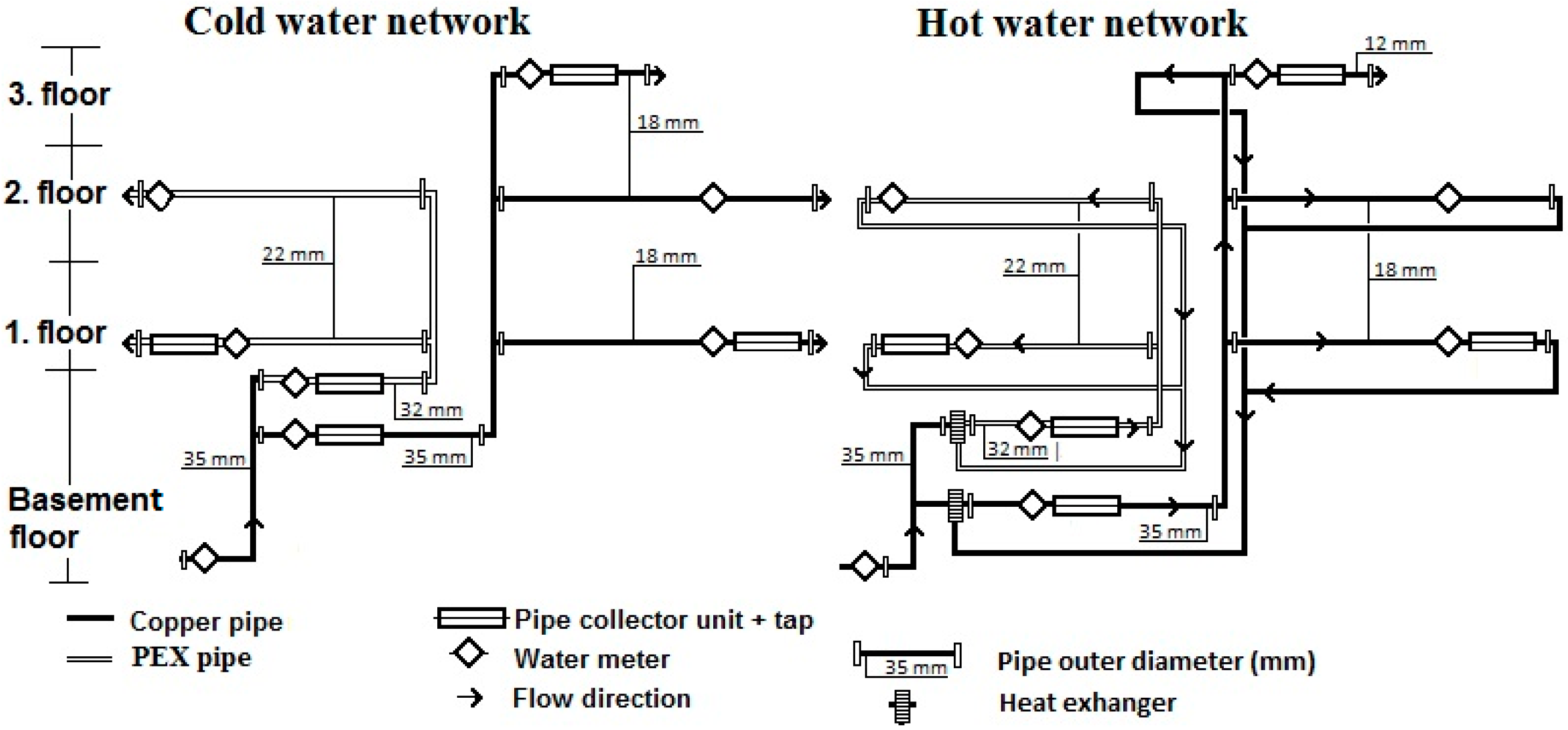
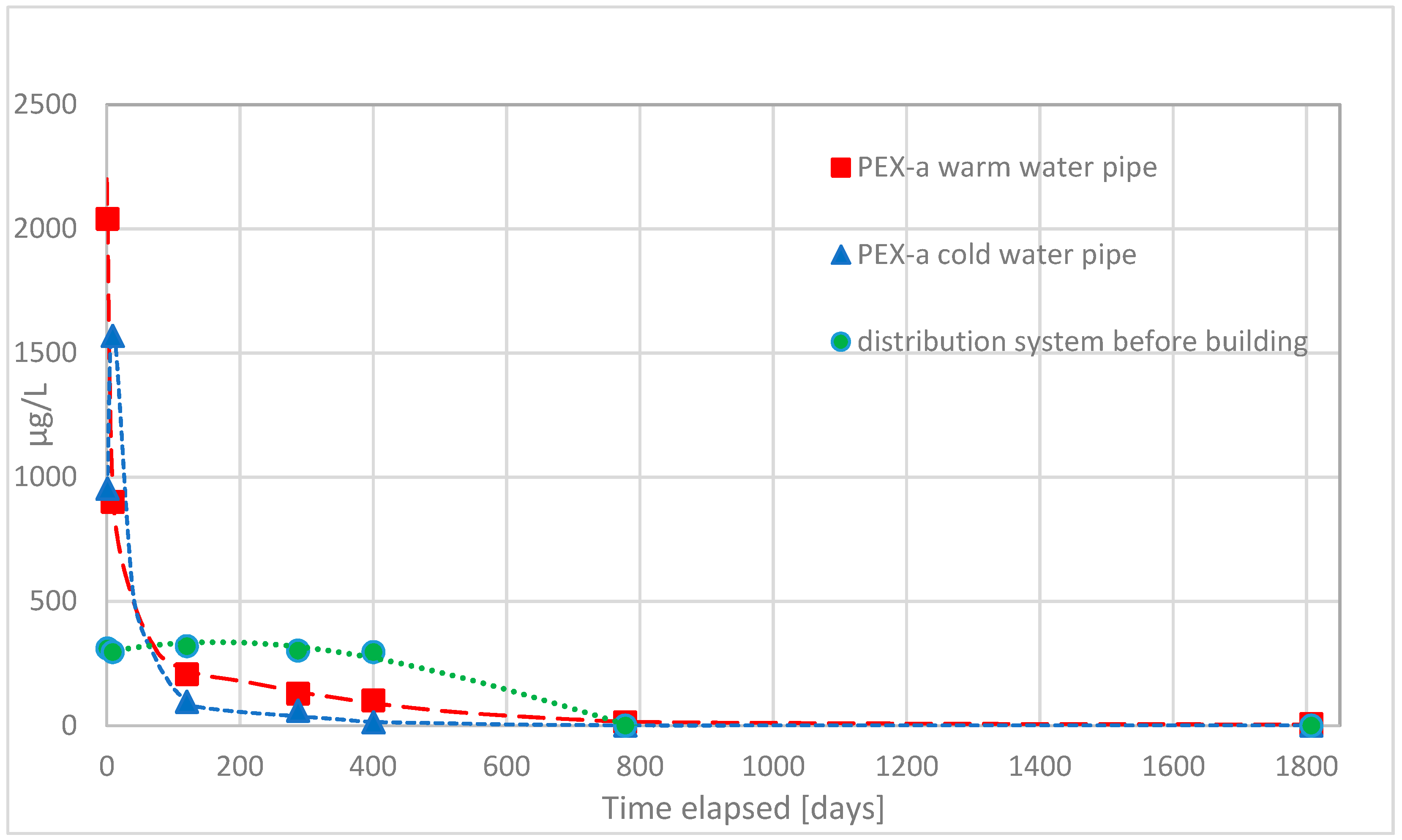
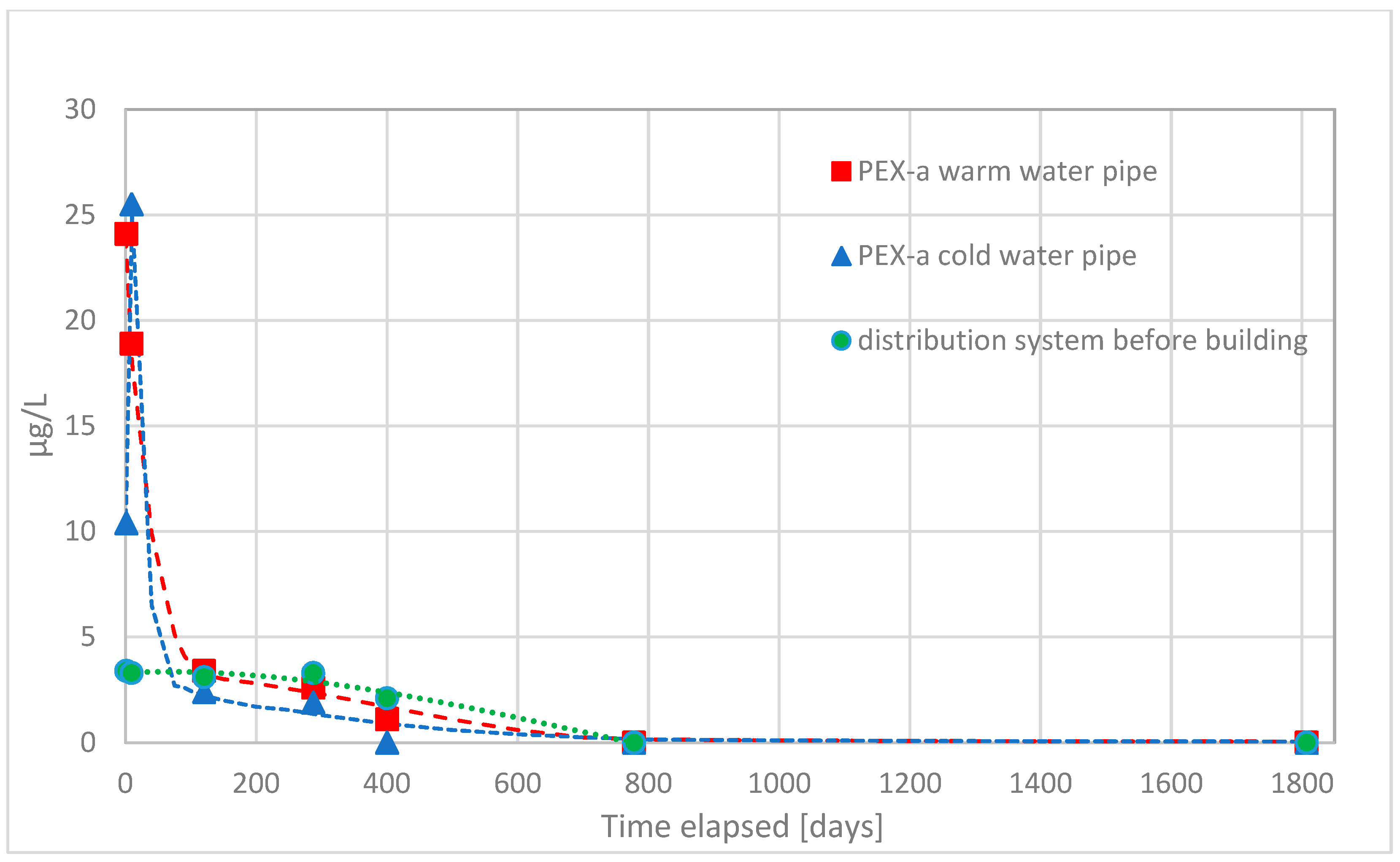
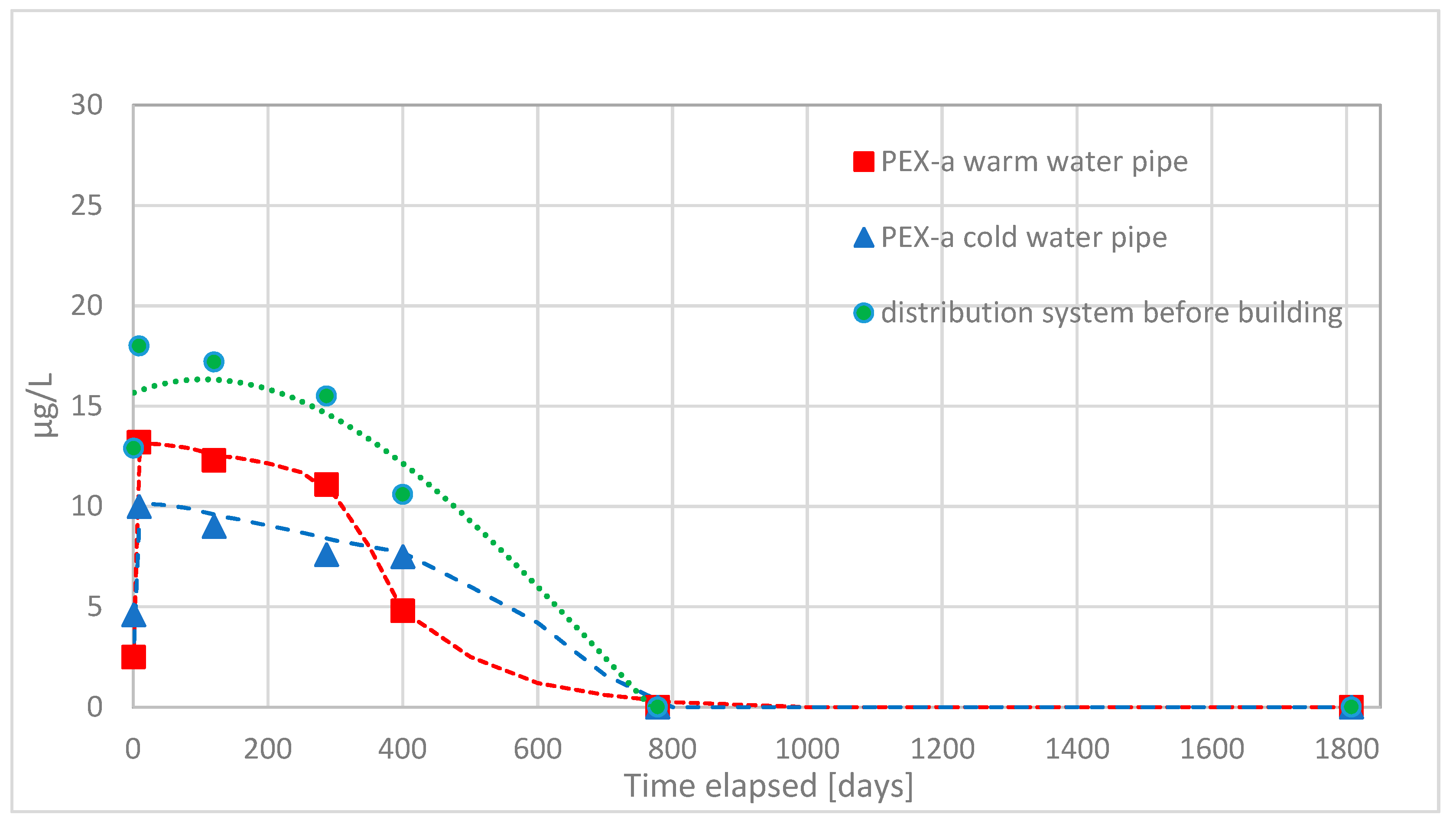

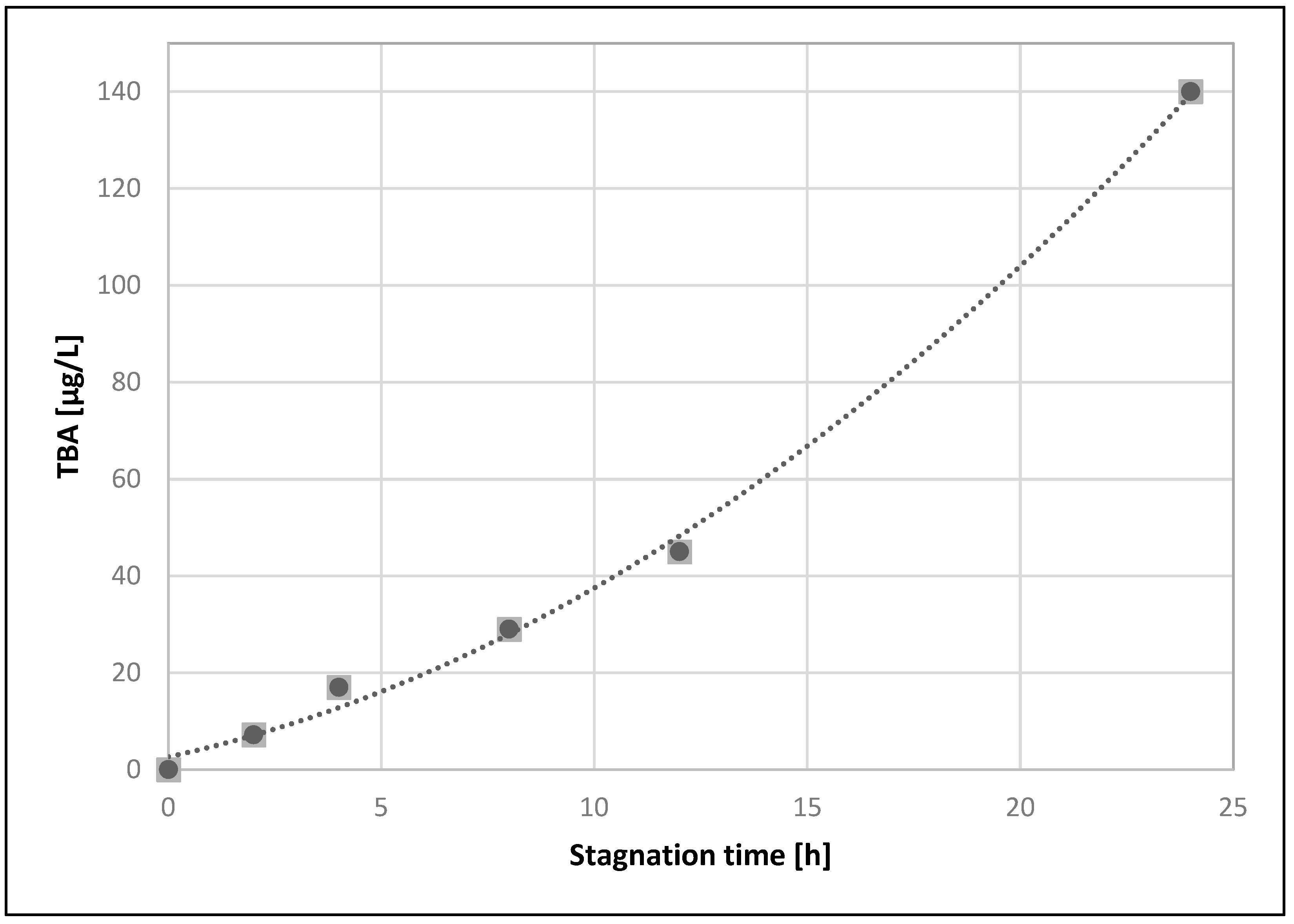
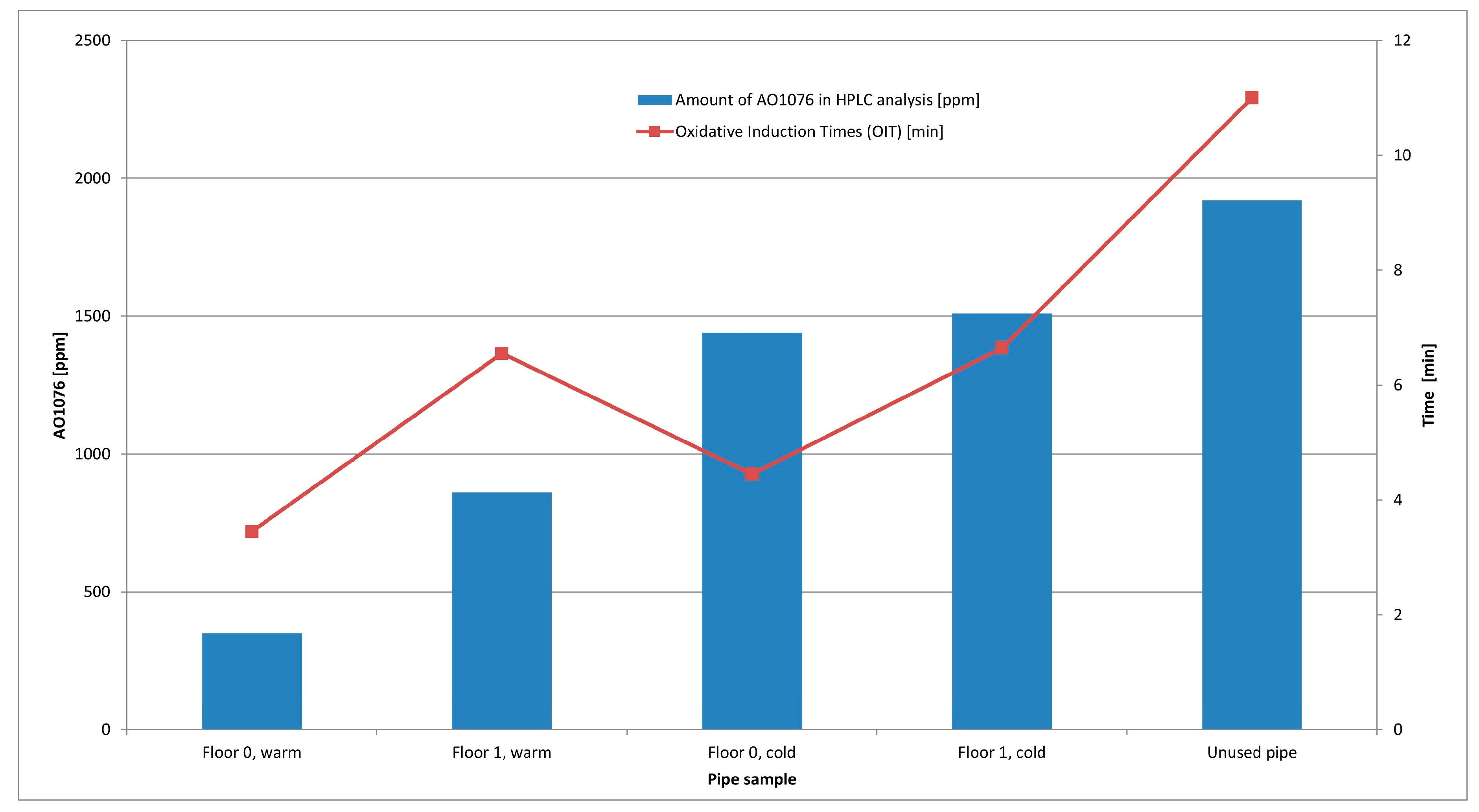
Publisher’s Note: MDPI stays neutral with regard to jurisdictional claims in published maps and institutional affiliations. |
© 2021 by the authors. Licensee MDPI, Basel, Switzerland. This article is an open access article distributed under the terms and conditions of the Creative Commons Attribution (CC BY) license (http://creativecommons.org/licenses/by/4.0/).
Share and Cite
Pelto-Huikko, A.; Ahonen, M.; Ruismäki, M.; Kaunisto, T.; Latva, M. Migration of Volatile Organic Compounds (VOCs) from PEX-a Pipes into the Drinking Water during the First Five Years of Use. Materials 2021, 14, 746. https://doi.org/10.3390/ma14040746
Pelto-Huikko A, Ahonen M, Ruismäki M, Kaunisto T, Latva M. Migration of Volatile Organic Compounds (VOCs) from PEX-a Pipes into the Drinking Water during the First Five Years of Use. Materials. 2021; 14(4):746. https://doi.org/10.3390/ma14040746
Chicago/Turabian StylePelto-Huikko, Aino, Merja Ahonen, Mia Ruismäki, Tuija Kaunisto, and Martti Latva. 2021. "Migration of Volatile Organic Compounds (VOCs) from PEX-a Pipes into the Drinking Water during the First Five Years of Use" Materials 14, no. 4: 746. https://doi.org/10.3390/ma14040746
APA StylePelto-Huikko, A., Ahonen, M., Ruismäki, M., Kaunisto, T., & Latva, M. (2021). Migration of Volatile Organic Compounds (VOCs) from PEX-a Pipes into the Drinking Water during the First Five Years of Use. Materials, 14(4), 746. https://doi.org/10.3390/ma14040746





